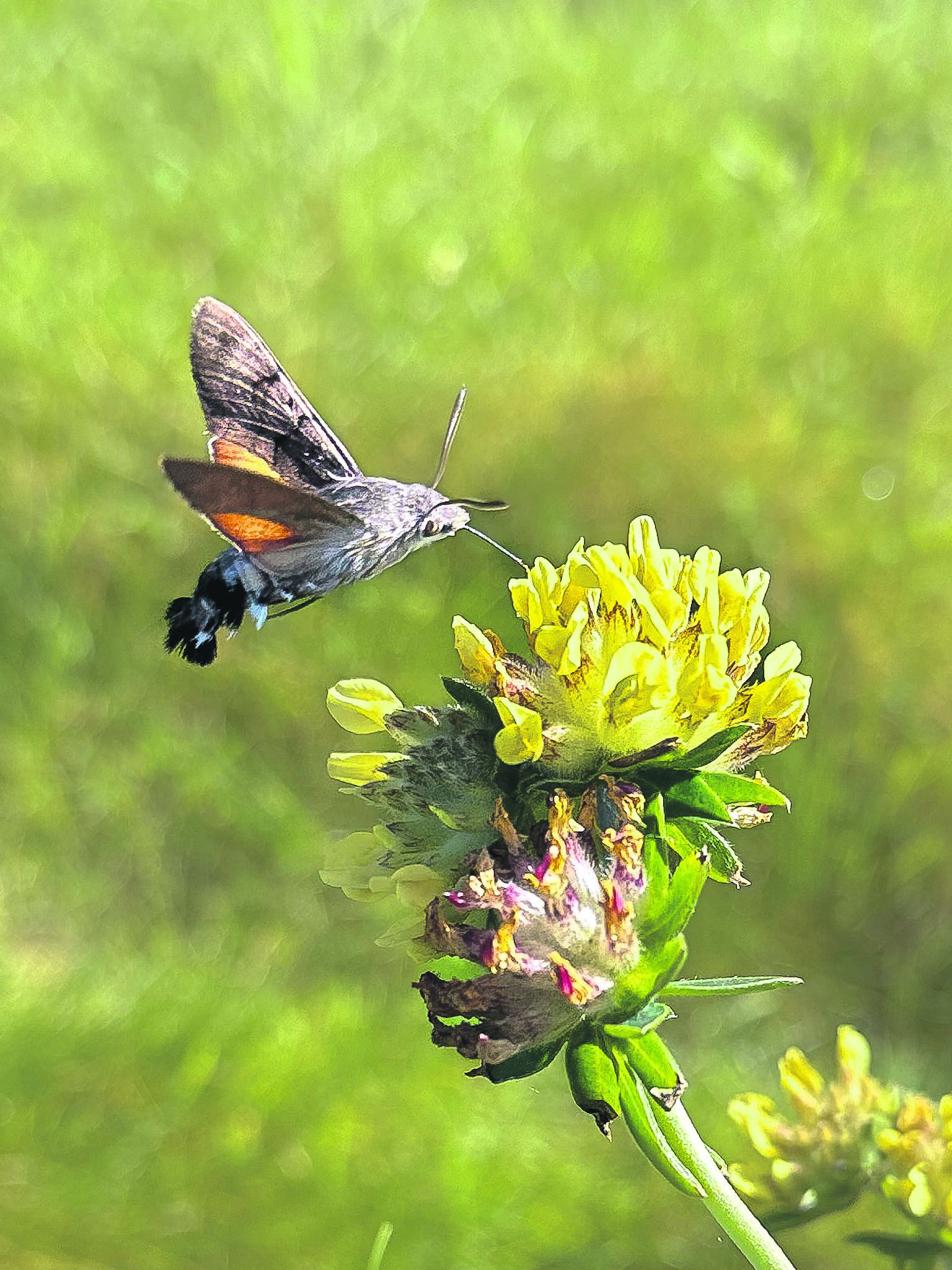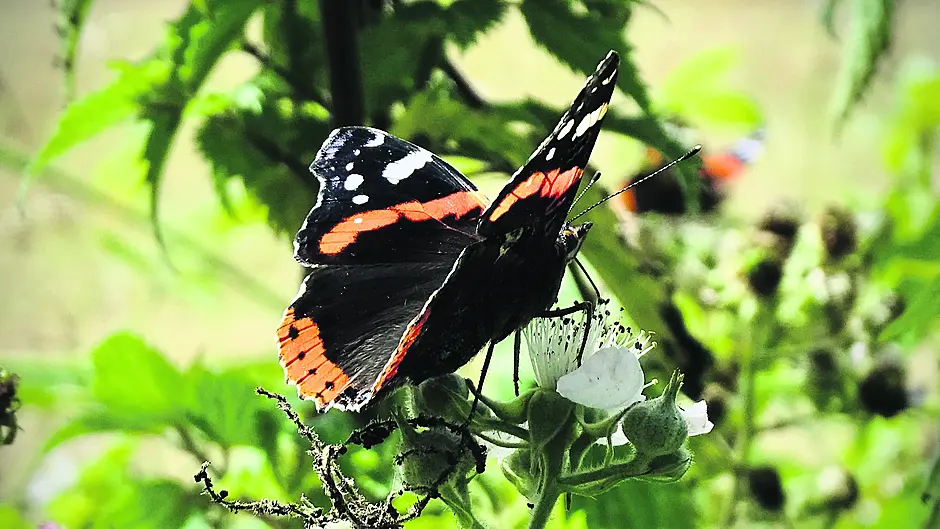BY ANN HAIGH
THE migration of birds, such as swifts and swallows, is often written and spoken about. These animals make epic journeys to reach Irish shores each year. However, insects who make equally mind-blowing journeys often seem to be less acknowledged.
It probably seems impossible to believe that creatures such as butterflies and moths can cross oceans and continents to reach our shores, but they do. Last month, I was reminded of this insect migration by the wondrous sight of a hummingbird hawkmoth in Squince, near Union Hall.
Hummingbird hawkmoth
Appearing more like a tiny bird than a moth, these beautiful daytime fliers sometimes arrive here in early spring and summer. They hover, holding steady in the air as if by magic, next to their favoured flowers with their long proboscis (feeding tube) extended so they can sip nectar from within the flower.
 A mesmerising creature, a hummingbird hawkmoth seen feeding on kidney vetch in Squince last month.
A mesmerising creature, a hummingbird hawkmoth seen feeding on kidney vetch in Squince last month.
These striking creatures travel from southern Europe, with some years seeing more arrive than others. Given the reports and sightings so far, it seems like this might be a ‘good year’ for them, so keep your eyes out.
Another migratory moth, which is more common in Ireland, is the silver Y moth, so called due a y-shaped silver marking on each wing. These delicate moths join us from the Mediterranean basin and North Africa in spring. They breed in Ireland and their descendants return southward in the autumn.
Butterfly journeys
Journeying even further than the hummingbird hawkmoth and the silver Y moth is the painted lady butterfly. The painted lady is a classic example of a migratory butterfly. When it gets too hot in northern and sub-Saharan Africa, they start to move northwards and their journey may span up to 6,000km. Most make the journey in stages, stopping to reproduce en route, with the next generation continuing the push northward.
 A silver Y moth seen in Skibbereen last year, with their silver y-shaped wing markings evident.
A silver Y moth seen in Skibbereen last year, with their silver y-shaped wing markings evident.
Like the hummingbird hawkmoth, there are years where we don’t see many painted ladies, but on others we may see an influx. I saw several last year in West Cork and none so far this year, but I will be maintaining a close watch for them.
Again, like the silver Y, the bewildering thing is that after breeding here in Ireland, the next generation of painted ladies will undertake a return journey southward again. So, butterflies from caterpillars that have fed on our West Cork thistles and nettles, undertake flight towards Africa and the sub-Saharan area.
Two other migratory butterflies that arrive here from afar are the red admiral and the clouded yellow, both coming from as far as southern Europe and North Africa. It is thought that as our climate warms, more red admirals can stay and survive the winter and it will be interesting to see how the movement patterns of moths and butterflies will change over time.
Tracking journeys
You might wonder how scientists know where these butterflies and moths travel to and from. Unlike birds, they are obviously not big enough for identification rings on their legs or tracking devices.
Such information may be gathered crudely, by using dyes to mark their wings and then checking where the marked individuals are subsequently recovered, or by using forensic techniques, which analyse chemicals found in their wings. The wing analysis can inform where the butterflies spent time as caterpillars. A further method uses vertical looking radars which can detect the direction of insect flight. Even with these methods, there is still much we don’t know and now plenty more to study as we start to see those changes in movement patterns due to our changing climate.
How it happens
It also boggles the mind, as to how butterflies that develop from caterpillars born in Africa and Southern Europe know to fly north and how butterflies from eggs and caterpillars reared in Ireland know to fly south. Studies have shown that it is the lengthening or shortening of days while the caterpillars are developing that informs them. Caterpillars growing while the days are lengthening become adults who fly northwards. If the days are shortening, butterflies and moths are born with the innate sense that they need to travel south, to a warmer climate.
Day-flying moths and butterflies orientate themselves using the sun, but night-flying moths most likely use the Earth’s magnetic field to guide them. Studies have shown that silver Y moths in the UK migrate only on nights when winds are blowing southward, indicating that they detect their direction of movement while airborne, likely by a magnetic sense, and only rise when the wind is blowing in the right direction.
Helping hand
By having pollinator friendly gardens, free of pesticides and herbicides and with plenty of native wildflowers, you will be helping to sustain these creatures that have made such a gargantuan effort to get here.
Additionally, caterpillars of these migratory moths and butterflies feed on plants such as nettle, thistle, clover, bird’s-foot trefoil and bedstraw. Adults lay their eggs on these plants, so that the caterpillars have food and shelter in which to grow and develop.
Therefore, letting plants such as nettles and thistles grow, and allowing areas to go wild, will make sure there is ongoing habitat and food for these beauties. This is just the type of gardening I am able for anyway, so that’s lucky!
• Ann Haigh MVB MSc MRCVS is a Skibbereen resident, a mum-of-two and a veterinarian with a masters in wildlife health and conservation and she is passionate about biodiversity and nature.








